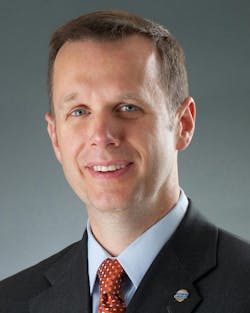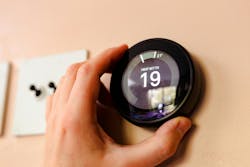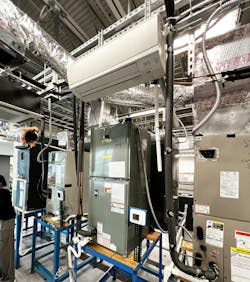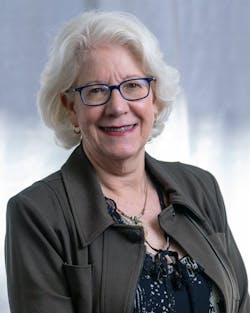2025 AHR Expo Trend Report
The Industry Trend Report serves this career diversity, designed to bridge the differences and offer thoughtful connection points regarding the industry’s current state ahead of Orlando. Each year before this event, AHR Exposition's endorsing associations provide a comprehensive view of the many roles within the industry, highlighting relevant discussion topics as tens of thousands of HVACR industry professionals prepare to meet in person.
From Air-Conditioning, Heating, and Refrigeration Institute (AHRI)
Steve Yurek/AHRI President/CEO
The transition from HFC refrigerants to their successors that began in 2011 is nearing completion and the industry is now working with regulators and NGOs to explore the feasibility and safety of moving to even lower-GWP refrigerants for some applications in the future. Our industry is also heavily involved in
decarbonization efforts, both in the United States and around the world, always focused on economic viability as well as technological feasibility. Other issues on our radar include increasing state efforts to regulate PFAS chemicals and plastics and packaging, as well as to implement extended producer responsibility programs.
Another hot topic is implementation of the tax credits contained in the Inflation Reduction Act - we await final guidance from the Treasury Department on that (as of September 2024).
The one major shift would likely be the discussion of A3 refrigerants in residential applications.
Our industry around the world is strong and innovative. Our member companies manufacture quality, reliable products and equipment that are essential to the health, wellbeing, and productivity of customers around the world.
From ASHRAE
M. Dennis Knight/President
The HVACR industry is rapidly expanding and plays a crucial role in addressing human health and the climate crisis through sustainable building practices. Despite this, we face a significant challenge in attracting new talent. Senior engineers and building scientists are aging out of the workforce, taking with them valuable expertise, yet not enough younger individuals are stepping in to fill their shoes. This disconnect largely stems from a perception problem.
Our industry’s vision — creating energy-efficient, healthy, and carbon-neutral buildings — must be more effectively communicated. Young people seek meaningful and purpose driven careers, and the HVAC&R industry has the potential to fulfill these desires. We need to demonstrate how our work directly impacts indoor environmental quality, climate action, and sustainable development. By showcasing the real-world impact and future possibilities of our industry, we can inspire the next generation to pursue careers that contribute to a healthier planet and better quality of life for all.
Building Decarbonization: ASHRAE’s goal is to achieving net zero GHG emissions in operation for all new buildings by 2030. We have held global summits on building decarbonization in Washington, DC, Madrid, Spain, Athens, Greece, Delhi, India and have one coming up later this fall focused on high rise buildings in New York City, NY. The CEBD is producing 14 guidelines and a Standard that will allow carbon emissions by buildings to quantified, accounted for and reported consistently around the world.
Rapid advancements in technology and AI, along with a focus on sustainability, energy efficiency, and resilient building systems, are driving innovation in the HVAC&R industry at an unprecedented pace. However, this progress also brings a pressing need for skilled professionals. By combining technological power with human creativity, both experienced professionals and new talent can work together to shape the future of our industry.
Workforce Development: ASHRAE members are collaborating on a grassroots campaign to educate others about our industry’s role and contributions. We will promote the current work and future opportunities in HVACR that will impact indoor environmental quality, climate change and sustainable development for all humanity. This work will have an even more significant impact as the world’s population grows from 8 billion today to 9.7 billion in 2050. We are sharing new tools and resources that our members can tailor to include their own personal stories, observations, passions and motivations.
From Associated Air Balanced Council
Jeremy Johnson, board member; Al Lapera, education committee member
Today the HVACR industry is strong and prosperous. Advances in technology still continue to be the most exciting and challenging part of the industry. An overarching trend toward decarbonization and electrification of buildings will mean that commissioning and energy management are even more of a focus. The ever-changing landscape requires those in the industry to constantly be learning, growing, and adapting while still maintaining the fundamentals of the HVACR industry.”
Increasing Complexity: With developments in software systems, hardware, and artificial intelligence, the industry is becoming more complex. Long-term changes in the industry will challenge not only those who currently service and maintain systems, but also will require advanced thinking in design and engineering.
From the Association for Smarter Homes & Buildings
Greg Walker, CEO
In recent years, the industry has shifted from traditional systems to more integrated, intelligent solutions. This change is driven by the need for greater efficiency, reduced environmental impact, and the growing demand for connected, data-driven building management.
Smart Building Integration: The seamless incorporation of HVACR systems into smart building platforms, enabling more efficient, automated control and monitoring.
Indoor Air Quality (IAQ): A heightened focus on IAQ, driven by post-pandemic health concerns, is leading to innovations in ventilation, filtration, and real-time air quality monitoring.
Energy Efficiency and Sustainability: The push for net-zero energy buildings is putting pressure on HVACR systems to be more energy-efficient and environmentally friendly, with an emphasis on heat pumps, advanced refrigerants, and renewable energy integration.
IoT and Data Analytics: Leveraging IoT and advanced data analytics to optimize HVACR performance, predict maintenance needs, and enhance system longevity. Resilience and Adaptability: As climate change intensifies, there’s a growing demand for HVACR systems that can adapt to extreme weather conditions and ensure reliable operation in diverse environments.
The drive towards sustainability and decarbonization is a critical challenge as the industry faces increasing pressure to reduce carbon emissions, adopt low-GWP refrigerants, and enhance energy efficiency. This shift demands not only technological innovation but also significant investments in research, development, and workforce training to ensure that HVACR systems can meet stringent environmental standards without compromising performance.
Simultaneously, the integration of HVACR systems with smart technologies presents another pressing issue. The need for seamless interoperability across different devices and platforms in smart buildings is crucial for maximizing energy efficiency, improving indoor air quality, and enhancing overall building performance. As more buildings and homes incorporate smart systems, ensuring that HVACR technologies can effectively communicate and function within these environments is essential for the future of the industry.
One area that is being closely monitored is the evolving regulatory landscape, particularly concerning refrigerant regulations and energy efficiency standards. Staying compliant with these regulations while maintaining system performance and cost-effectiveness is a significant concern for industry stakeholders. The impact of climate change on HVACR system design and operation, including the need for more resilient and adaptable systems, is also a critical issue on the radar.
From National Comfort Institute
Dominick Guarino, CEO
We can no longer rely on rules of thumb and cheap testing instruments to set up or service systems.
We have to step up and technicians need to get the right training and tools to do the job right.
Greater focus on testing and verification of newer systems, especially with inverter technology. Much training and instrument upgrades are needed.
With all of the challenges we’re facing we must focus more on industry training. Not just through trade schools, but advanced training for the existing workforce.
- We have a shrinking workforce and not enough support for contractor training by manufacturers and distributors.
- Contractors who embrace new technologies and increase tech training and invest in better tools will win.
- A challenge is the next transition to zero GWP refrigerants and everything that comes with that.
- Better testing software and instruments will help move our industry forward.
- We are discussing tools and software to help service and install systems better, faster and more accurately.
From Plumbing-Heating-Cooling Contractors --National Association
Cindy Sheridan, CEO
In the near term, getting technicians comfortable with new products will be important. However, the long-term plan should be to develop a consistent, consensus-driven and realistic vision of regulatory requirements ensuring products and installations can meet consumer needs in a practical and economically viable form without eliminating certain consumers from the market.
Our nation’s energy portfolio must remain diverse as we transition to less carbon-intensive solutions. Regulatory changes to consumer water heaters, furnaces, and boilers are concerning to our members, who cite increased costs to convert to these new products particularly when retrofits are necessary to accommodate those products.
Decarbonization: Certain states, specifically New York, California, and Massachusetts continue to take a more aggressive posture toward energy decarbonization policies. PHCC continues to work with industry stakeholders to identify ideal solutions and understand consumer impacts of federal and state decarbonization policies.
Heat pumps: PHCC is working to position its members as the primary professional resource in their markets for heat pump technology. As the heat pump market matures, PHCC remains optimistic that heat pump technologies will remain accessible to all consumers.
Refrigerant and Regulation Issues: The AIM Act instructed EPA to ensure competent personnel are doing this work. PHCC strongly supports stronger enforcement of licensing and certification requirements to ensure safe and optimal performance of advanced heating and cooling systems.
Workforce: PHCC continues to advocate for a robust federal workforce funding framework that provides avenues for younger workers to seek careers in the skilled trades such as plumbing and HVAC. Workforce Innovation and Opportunities Act (WIOA) grants provide sufficient funds for employers to educate the next generation of plumbing and HVAC professionals. Perkins Career and Technical Education (Perkins CTE) provides funding for secondary schools to introduce students to skilled trades. PHCC supports funneling Pell Grants to short-term in-demand job training that will be particularly beneficial to those seeking work in HVAC.
Pressing Issues: There are many “unknowns” in implementation of HOMES and HEARS rebate programs, in addition to 179D tax incentives. As a national association, it requires a lot of bandwidth to keep track of each state’s program developments, and communicate those developments to our state chapters and members. Contractors are particularly concerned about how rebates will work and whether they will be fully compensated by the time work starts, how long they will have to wait to receive compensation, how long a homeowner will have to wait to have work performed, and whether the rebate will be sufficient to offset costs.








